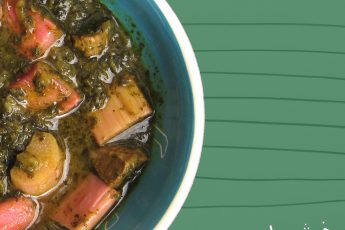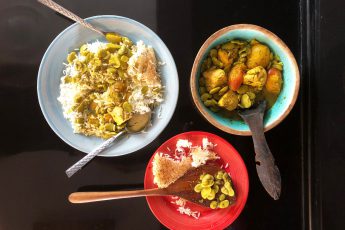Hi everyone! As we speak, I’m off on my excellent adventures in Iran, but my mom and I made this khoresh earlier and I scheduled it to post now. Hope you’ll like it!
You may recall that Khoresh is the quintessential pillar of Persian cooking – a genre of food that encompasses an eclectic variety of tastes and flavors. More elaborate and sophisticated than a typical stew, khoresh is a slow-fusion combination of meat (or poultry or fish) cooked with fresh or dried fragrant herbs and vegetables, or fresh or dried fruits, grains, or legumes.
This recipe is for a type of khoresh known as aloo esfenaj – although some call it the other way around: esfenaj ‘o aloo. It is made with lots of esfenaj (spinach) and also plenty of aloo (plums.) Typically, the type of plums used for the khoresh aloo esefenaj are dried yellow ones known as aloo bokhara , but prunes (dried black plums) are a common substitution, specially outside of Iran where aloo bokhara are not easily found.

My mother reports that my grandmother used to often make khoresh aloo esfenaj — and it is one of my mom’s favorites. It is one of my favorites types of khoresh as well. There’s something undeniably luscious about the combination of cooked prunes, spinach and meat — with that signature flavor profile of Iranian food of being harmoniously savoury, tart and sweet all at once.
As notoriously complicated as Persian rice is to make, Persian stews make up for it by being quite forgiving and easy going, and this delicious khoresh is no exception. In the spirit of keeping things short and sweet, let’s click our heels and head straight over to the recipe.

- 1 pound stewing meat, cut into 1″-1 1/2″ cubes( preferably lamb or veal, beef may also be used but Iranians in general do not cook with beef)
- 2 pounds (washed, stemmed, coarsely chopped) fresh spinach
- 8 ounces pitted prunes (rule of thumb: allow 4-5 prunes per person served)
- 1 large onion (finely sliced)
- a few pinches of turmeric
- 1/4 cup fresh lemon juice ( more or less according to tartness preference/taste)
- a tiny pinch of saffron
- 1/2 teaspoon cinnamon
- 6-8 tablespoons olive oil
- salt and pepper to taste
- Heat 3-4 tablespoons of oil in a roomy nonstick pot over medium high heat till sizzling hot. Add chopped onions. Saute till golden (approximately 10 minutes) while stirring occasionally. Add meat. Add turmeric, salt and pepper. Sautee for 5-6 minutes till the meat is no longer pink/red. Add 3 cups of water and bring to a boil. Once boiling, cover pot with lid, reduce heat to medium low and simmer cook till meat is cooked. (Approximately 45 minutes for veal or lamb, up to an hour for beef.)
- While meat is cooking, saute chopped spinach in 3-4 tablespoons of sizzling hot oil in a nonstick skillet, stirring frequently, until the spinach’s liquid is expelled and it reduces in bulk (approximately 5-6 minutes.) Season with salt and a pinch of turmeric. Set aside. Rinse and dry prunes. Saute prunes in a tablespoon of sizzling hot olive oil for no longer than a minute in a nonstick skillet. Set aside.
- Once meat is almost done, remove lid, turn up the heat till the stew is boiling. Add spinach, prunes and fresh lemon juice. Sprinkle with saffron and cinnamon. Stir once with a wooden spoon to mix. Reduce heat to medium low. Cover lid and simmer for an additional 15-20 minutes.
- Once done, taste and adjust seasoning with salt and lemon juice to taste. Transfer stew to a deep serving bowl. Serve hot.
Khoresht ‘eh aloo esefenaj is (like all the other types of Persian stew) is traditionally meant to be served with a bed of fluffy Persian rice. Alternatively, however; you may enjoy this Persian stew over a bed of quinoa, or, with flat bread.






Looks like the perfect recipe and fairly easy and I think I could find most things in my pantry…except for the yellow dried prunes. I think I will have to stick with the regular dark prunes. I have been so enjoying your photos on Instagram…looks like a wonderful trip!
I love this stew, I have only had it once but remember it vividly. I will have to try making it.
It’s great! this dish looks really yummy… spinach, lemon, cinnamon and so on… I’m sure the taste was amazing! I saw a lot of pictures on FB and Instagram, I hope that your trip is great how it appears!
Oooh waw, this would be also very tasty when you use rabbit meat,…mmmmm! Wonderfully fragrant too! xxx
“Iranians in general do not cook with beef”
I’m Iranian and that statement is so false! Sure, lamb/veal are also used for stews, especially during special occasions, but I’d say that beef is more common. SUCH a ridiculous, uppity statement to make!
Sorya khanum, is there a reason you are taking this so personally? I assure you that you can express your opinion without being offensive and there’s no need to get hot under the collar. Take care!
lol I bet you don’t even know who Googoosh is
Midoonam ke kaj kollah khan yaresh bood.
It is funny how people can be both arrogant and wrong. Soraya khanum is probably yet another rootless Tehrani who really knows nothing about Iran. Actually up until 30-40 years ago, beef was RARELY used in stews in Iran . It is still considered a heresy by connoisseur to cook a khoresh with beef. It is cheaper though and became more common as meat consumption kept increasing.
On a separate point, I should add my two cents on using olive oil. Olive oil, especially when cold pressed, should not be heated to “sizzling” levels because it breaks down even at moderate temperatures. Besides, olive oil has a characteristic flavor that in the wrong context can take over other spices.
Salam dear Shekamoo! I am fond of all shekamoos and appreciate your comment.
It’s interesting to hear your take re BeefGate (ha ha) & honestly it’s how I learned the tricks of the trade from my mother.
I’m also going to blame her re the use of olive oil. My mother exclusively uses olive oil for her cooking and that’s what I picked up as well. However, the point you make is salient. So let me ask you: what type of oil would you recommend to heat to the sizzling point?
Thanks for posting this recipe – I have been looking to replicate this since an ex-boyfriend’s mom used to make it with chicken legs. One of my favorites (along with zareshk polo and jujeh kebab)!
Sorry Soraya couldn’t be civil! Very odd…
Thank you dear KDM for the moral support <3 and thrilled that you've found the recipe you've been looking for. Hope it does the trick! Nooshe' joon!
[…] Khoresh Aloo Esfenaj […]
Dear Azita, I’m preparing khoresh esfenaj aloo right now for a dinner with friends, and I thought it was time to thank you for this recipe — I keep coming back to it as I think the result each time is spot on. Thus kheily mamnoon to you and your mother and her mother for this recipe that brings back such profound memories.
Dear Nicolas, thank you so much for such a lovely message. 🙂 I’ll pass on the message to my mom as well and delighted to hear that you enjoy the khoresh. Nooshe’ jaan!